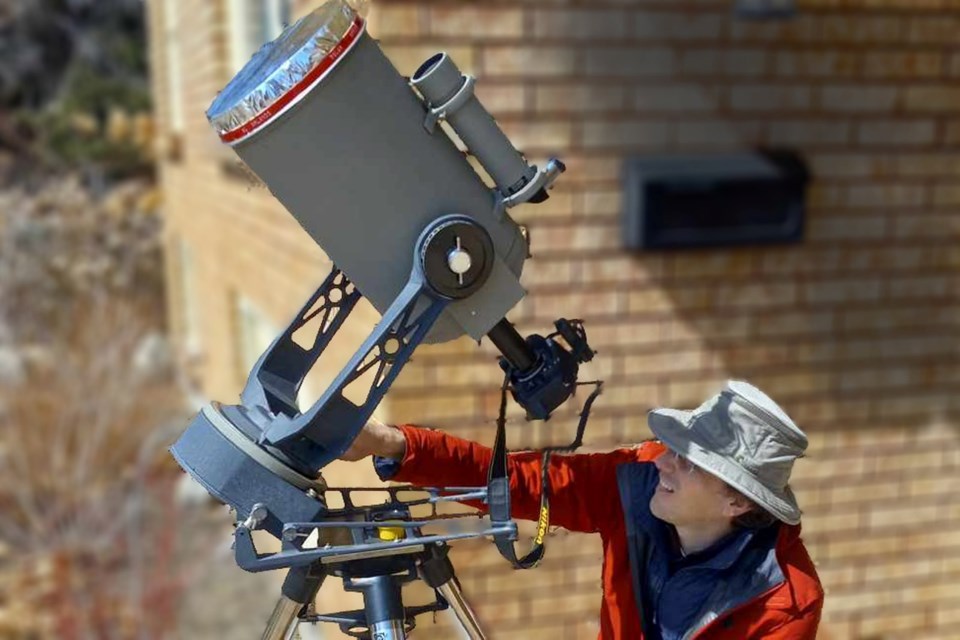Editor's Note:
The Canadian Space Agency website has simple instructions on how to make a projector using an empty cardboard box, a sheet of white paper, aluminum foil, a pin, tape and scissors.
For instructions, click here.
-----
On Monday afternoon, the long-anticipated total solar eclipse will be upon us.
The weather locally calls for a mix of sun and cloud with a high of 14.
Standing on a specific 185-kilometre-wide path will result in witnessing the moon completely cover the sun. Along the centre of this path will result in a maximum of three to four minutes of totality.
This path starts in Mexico and then continues over the border through Texas, Arkansas, Missouri, Illinois, Indiana, Ohio, Pennsylvania, New York, and Vermont ending in Maine. In Canada, residents in parts of Ontario, Quebec, New Brunswick, P.E.I. and Newfoundland will also witness this amazing event. For the rest of Canada and the United States, only a partial eclipse will be seen. Although favoured in the east, even Vancouver will see 17% of the sun covered at the maximum.
Never look at the sun without a solar filter. When purchasing certified eclipse glasses, always buy from a reputable telescope dealer but many are selling out of stock.
Never use a do-it-yourself hack seen online as this could be a recipe for eye damage if not blindness. Sunglasses are great when driving, walking, etc but should never be used to look directly at the sun. If eclipse glasses cannot be found, a piece of number 14 welder’s glass can also be used.
When using a telescope, binoculars or camera always place the filter in front to reduce the sun’s glare before it is magnified or imaged. Never place a filter behind the eyepiece as the concentrated solar beam acts as a laser and melts the filter and unfortunately your eye. You will also damage or melt your camera or smartphone sensor.
If a solar filter or welder’s glass is not available you can use a simple spaghetti or vegetable strainer or virtually anything with small round holes. Hold the kitchen tool about a foot off the ground and look at the projection of numerous semi-circles as the moon moves in front of the sun. You can then take a picture of the projection safely as you are not looking directly at the bright solar disk.
A pinhole camera made from a cereal box is a great project with children. Plans can be found online.
Many public viewing events with dedicated astronomers using solar telescopes will be planned so check your area for these gatherings. This is a great opportunity to look through telescopes and learn about the sun.
Once the moon completely covers the sun along the eclipse path will it be safe to look at. Even though solar filters and solar telescopes are designed to examine the surface of our daytime star, the outer corona is only observed with human eyes during totality. This will appear as a halo around the sun. Look for the bright planet Jupiter up at the 11 o’clock position and Venus down at five o’clock. Be aware of how long the totality is listed for your area to know when to hold up the filter before the bright sun emerges from behind the moon.
With the above-mentioned safety precautions and a little luck in the weather, this will be a moment in time that you will never forget. Feel free to email me your questions via my website.
Meanwhile, the OPP wants to remind residents and tourists to prioritize safety while travelling or attending events and celebrations during the solar eclipse.
On April 8, 2024, a total solar eclipse will cross North America. A total solar eclipse happens when the moon passes between the sun and earth, completely blocking the face of the sun. Historically, eclipses have prompted mass movements of people to prime viewing areas.
Residents and tourists are encouraged to make road safety a top priority when travelling to take part in solar eclipse events:
- It is essential to wear special eclipse glasses with filters designed for watching solar eclipses, but do not wear eclipse glasses while driving.
- Do not photograph or video the eclipse while driving.
- Share the road when attending large gatherings and never pull over or stop on the roadway and/or shoulder of the road to view the eclipse. Exit the roadway and park in a safe area away from traffic to view the eclipse.
- Be prepared for delays in getting to and from your destination, including being aware of possible increased pedestrian traffic.
- Check local community news or websites for advisories relating to traffic management such as detours and parking.
- No amount of alcohol or drugs in your system is safe while driving. If you suspect that someone is driving while impaired, it's important to call 911 to report it.
If you plan to be on the water during the solar eclipse, the OPP encourages boaters and paddlers to be well-informed about safe boating practices and laws to help ensure an enjoyable and safe time:
- Ensure your boat is equipped with all the necessary safety gear and navigation tools including proper lighting, especially during low-light conditions.
- Familiarize yourself with any regulations or restrictions in the area where you plan to view the eclipse. Some waterways may have specific guidelines for boaters during special events such as the solar eclipse.
- Boaters and paddlers are vulnerable to unexpected changes in weather and wind conditions, making it important to ensure you and your vessel are well-prepared every time you go out on the water.
- Always do a thorough check of your boat and safety equipment before heading out on the water.
- Alcohol/drug-impaired operation of a motorized marine vessel is dangerous and carries the same penalties as impaired operation of a motor vehicle.
To learn more about the solar eclipse, visit the Government of Canada's Canadian Space Agency website.



